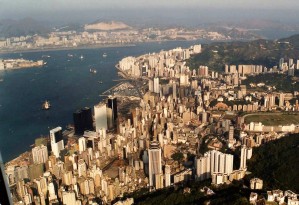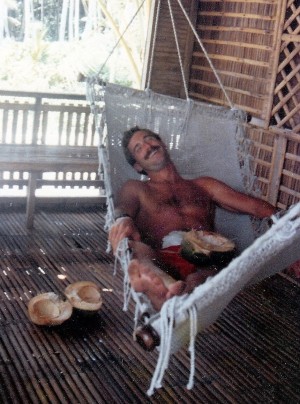Author’s Note: This is a series of selected highlights from two years (1986-88) of budget backpacker travel through 15 countries and a half-dozen US States – hosted all along the way by national and local YMCAs – from the Pacific Islands to selected Asian countries including: Indonesia, Singapore, Malaysia, Thailand, Burma, The Philippines, Hong Kong, Macau, China, Taiwan, Korea, Japan – and the USA.

Once again, the Mielke brothers would tempt doom and strike off together for more fun-filled adventures. This time, we met up in the flea-bitten but affordable traveler flophouses of Hong Kong, where we took day trips around the city, to the outlying islands, and over to Macau.
Entering China, we proceeded to Guangzhao City and sailed up the Pearl River to Zhaoqing Prefecture, a spectacularly scenic part of southern China’s Guangdong Province, where we rented bikes and cycled through rice fields spiked with tall limestone “karst” mountains – each topped with a tiny temple.
Popular with Chinese tourists, the dramatic landscape around Xhaoqing is reminiscent of the world famous and heavily touristed Guilin Prefecture, but more laid back and less crowded.
But all of this had to wait until after my release from a three-day stay in hospital. Having just arrived from the States, Dave got a shock when he was handed a note at the hostel saying that I was in hospital — but with no details about my condition, so he set about finding his way there.

I had slipped in the shower and developed a nasty infection in my lower leg. But compared to my tiny box-like room at the high-rise Chung King Mansions — well known as nearly the cheapest accommodation in Hong Kong, popular with backpackers with names like “Moonbeam”, the well-used sheets alive and itchy with the creepy sensation of minute critters crawling all over your body, and notorious for drugs and other criminal activities — my spacious four-bed shared room at Hong Kong’s Queen Elizabeth Hospital was a deluxe and luxurious penthouse.
Complete with three good meals, color TV, round the clock diligent nursing care, a beautiful view of the harbor from my window, and excellent medical treatment that brought my infection under control within a few days.
And at about $3 US dollars per day (even as a foreigner) for my in-patient stay, it was a far better deal than even the cheapest rooms at Chung King Mansions, and I was sad to eventually be discharged from the hospital and return to my tiny roach-motel room.

Hong Kong was like a huge, space-age Disney World – but in real life! A spectacularly beautiful, fast-paced city – you practically had to run to keep up with the masses of rushing pedestrians – and with a great harbor, night lights, and efficient public transport. Like a giant computerized machine all programmed to run smoothly — but expensive.
I met with staff members at three YMCA centers – two choice locations on the Kowloon mainland, including the headquarters of the Asia and Pacific Alliance of YMCAs, and a spectacular high-rise accommodation on Hong Kong Island. As elsewhere in the region, it was apparent that the early Christian missionaries had done well — managing to acquire some of the choicest pieces of real estate for the YMCA.
The lure of more unexplored territories took us on to Macau by hydrofoil across the channel to the oldest European settlement in the East — leased to Portugal as a trading post in 1557, then handed back over to China in 1999, and now a hugely popular casino and gambling center. And with over half a million people living in a area of just 30.5 sq kms (about 12 sq miles), it is the most densely populated region in the world. It was intriguing to imagine this place 150 years ago with clipper ships and the early traders as described in James Clavell’s novel “Tai Pan.”

Armed with a simple phrasebook, we crossed the border from Hong Kong into China’s Guangdong Province, and made our way up the Pearl River packed in with an overnight boatload of students – stretched out in open, box-like structures that separated our sleeping quarters.
At the time (1987), all foreign visitors to China were required to use Foreign Exchange Certificates (FEC) issued by the Bank of China. Only certain, special “Friendship Stores” and specifically designated hotels could accept FECs, which restricted where foreign visitors in China could stay and shop.
Of course, this created a huge black market. Foreigners, fed up with the limited options available with their FECs, wanted to have the local currency to use in regular Chinese restaurants and shops. The Chinese too, wanted FECs so that they could buy the “luxury” goods — like Johnnie Walker Red Label and Marlboro cigarettes.

So, at the Chinese border I exchanged a $20 US dollar traveler’s check for the FECs and then promptly traded them on the street for a huge pile of small, torn and grimy bills known as ‘The Peoples Money’ or Renminbi.
Riding local buses through open countryside past steep, limestone mountains and the surrounding rice fields, we toured the area for 10 days, staying in magnificent old 1930’s era hotels, eating a wide variety of local food – not always sure what it was, and guzzling an assortment of excellent local beers –- all for about $15 US dollars.
When we arrived at the Hong Kong border, I was informed that the Renminbi could not be taken out of the country.

And I happily exchanged my remaining scraps of torn and grimy “People’s Money” for about $5 US dollars equivalent in Hong Kong dollars. Clearly the best deal yet for budget traveling – and a very pleasant experience overall!
Stay tuned for Asia-Pacific Tour: Taiwan, Korea and Japan – coming soon!
You can read more about Jim’s backstory, here and here.










 The 1986 “People Power Revolution” had been largely confined to Manila, and we passed a military tank downtown. But otherwise, all was calm again, and we weren’t aware of armed conflict anywhere outside of the capital.
The 1986 “People Power Revolution” had been largely confined to Manila, and we passed a military tank downtown. But otherwise, all was calm again, and we weren’t aware of armed conflict anywhere outside of the capital.








